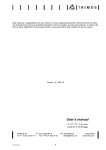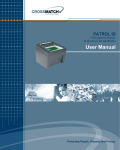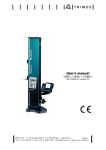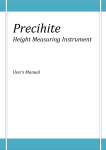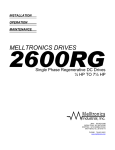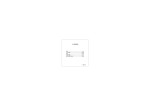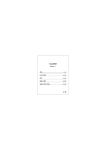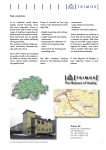Download User's manual
Transcript
Dear customer, congratulations for your choice, a Trimos measuring instrument. Over more than 30 years, our products have built up an excellent reputation in terms of quality, accuracy and longevity. In order to get also an entire satisfaction of the present product, we recommend to read carefully this user’s manual. Version 1.2 / 2002-08 User’s manual TRIMOS SA Av. de Longemalle 5 Tel ++ 41 21 633 01 01 Fax ++41 21 633 01 02 750 50 0001 03 1/28 CH 1020 Renens [email protected] Switzerland www.trimos.ch Contents Safety regulations..............................................................................................................................3 1.1 Important information....................................................................................................................3 1.2 Symbols used ...............................................................................................................................3 1.3 General warnings..........................................................................................................................3 2 Instrument description ......................................................................................................................4 2.1 Instrument construction.................................................................................................................5 2.2 Handwheel for measuring carriage displacement and probing (manual version)............................5 2.3 Display unit ...................................................................................................................................5 2.4 Interfaces/connectors....................................................................................................................5 3 Getting started ...................................................................................................................................6 3.1 Packing list ...................................................................................................................................6 3.2 Setting up .....................................................................................................................................7 4 Getting started ...................................................................................................................................9 4.1 Setting into operation ....................................................................................................................9 5 Basic functions ................................................................................................................................10 5.1 Selection of surface / diameter and centerline distance measurements.......................................10 5.2 Surface measurements...............................................................................................................10 5.3 Diameter and centerline distance measurements........................................................................11 6 Secondary functions .......................................................................................................................12 6.1 References .................................................................................................................................12 6.2 Selection of the resolution...........................................................................................................12 6.3 Setting / memorizing of the probe constant .................................................................................12 6.4 Selection of the measuring unit: mm/inch ...................................................................................12 6.5 Measuring in Min / Max / Delta mode..........................................................................................13 6.6 Zero setting of the display ...........................................................................................................14 6.7 Checking of squareness deviation...............................................................................................14 6.8 Angle measurements ..................................................................................................................16 6.9 Difference between 2 measurements ..........................................................................................17 6.10 Tolerance limits mode .............................................................................................................17 6.11 Complete clearing of the buffer ...............................................................................................18 6.12 Clearing of the last displayed value in the buffer......................................................................18 7 Programmable function keys ..........................................................................................................19 8 Configuration (Set-up).....................................................................................................................19 9 Data communication........................................................................................................................21 9.1 Data transfer...............................................................................................................................21 10 Application and adjustments .......................................................................................................22 10.1 Application of the manual and the motorized handwheel .........................................................22 10.2 Display ....................................................................................................................................22 10.3 Probing movement ..................................................................................................................23 10.4 Battery pack (operational lifetime, power capacity…)...............................................................23 10.5 Test of luminous LED's............................................................................................................24 10.6 Measurement with / without air cushion displacement..............................................................24 10.7 Reset mode.............................................................................................................................24 10.8 Adjustment of the measuring force ..........................................................................................25 10.9 Adjustment of the floating probe suspension............................................................................25 10.10 Position of the measuring insert in the holder .........................................................................26 10.11 Replacing the battery pack ......................................................................................................26 10.12 Temperature variations............................................................................................................27 11 Maintenance ..................................................................................................................................27 11.1 Cleaning..................................................................................................................................27 12 Technical specifications...............................................................................................................27 13 After sales service.........................................................................................................................27 13.1 Complaints / repairs.................................................................................................................27 13.2 Agents.....................................................................................................................................27 14 Declaration of conformity.............................................................................................................28 1 750 50 0001 03 2/28 1 Safety regulations 1.1 Important information In order to prevent any damages due to a wrong manipulation, please read carefully the following instructions. TRIMOS will not assume any responsibility in case of damages caused by inadequate use which is not in line with the present manual. 1.2 Symbols used The following symbols are used in this manual : General warning, utilization advices Risk of electric shock Electrostatic protection 1.3 General warnings Protection against electrostatic interferences: The static electricity can damage the electronic components of the instrument. In order to prevent this type of damages, avoid any contact with the connector pins. Switch on the power supply : The instrument should be switched on only when the electrical connections have been completed correctly. In order to prevent any changes of the instrument performance or any accident, the instrument should never be dismounted. The electronic display unit incorporates high voltage components. If, for any reason, the electronic unit needs to be opened, only authorized personnel is allowed to do it. Do not expose the instrument, its components and accessories to rain or any projection of fluids. Avoid penetration of foreign substances into the connectors and the instrument openings. In case of problems with the instrument or any of its parts (no display, overheating, anomalous smell, ..), switch off the instrument immediately and disconnect the power supply. Please contact your local TRIMOS agent. This is a high accuracy instrument. Particular care should be taken during its entire operational lifetime. Care mainly about the following specific points: - Use the instrument on a stable, smooth and clean surface plate. - Avoid any shock to prevent the characteristic features of the instrument from loosing its performances. - Use the instrument in a vibration free area. - Avoid the exposure to direct sunlight and excessive humidity. - Avoid the proximity of heating or air conditioning systems. - Respect the indicated environmental conditions. 750 50 0001 03 3/28 2 Instrument description 37 36 35 34 33 1 2 32 31 2.4 29 30 28 3 4 27 5 26 6 25 7 2.3 24 8 23 18 19 20 21 22 17 16 2.2 14 13 15 2.1 9 750 50 0001 03 10 4/28 11 12 2.1 Instrument construction 1. 2. 3. 4. 5. 6. 7. 8. 9. 10. 11. 12. 13. 14. 2.2 Column Upper measuring insert holder Screw for the adjustment of the floating probe suspension Transport safety screw for locking of the probe suspension (chromium plated) Lever for fast displacement of the measuring carriage (only on manual version) Screw for the measuring force adjustment Lower measuring insert holder Measuring insert Base with air cushion system for instrument displacement Operating handle for the displacement of the instrument Press button to activate the air cushion Programmable function keys Handwheel for measuring carriage displacement and probing movement (motorized version) Display unit (see details here-after) Handwheel for measuring carriage displacement and probing (manual version) 15. Handwheel for measuring carriage displacement and probing movement (manual version) 16. Locking device to activate the fine adjustment 17. Fine adjustment screw 2.3 Display unit 18. 19. 20. 21. 22. 23. 24. 25. 26. 27. 28. 2.4 Selection of references / numeric display of 7 / alphanumeric display of a b c Selection of resolution / numeric display of 8 / alphanumeric display of d e f Storage of probe constant / numeric display of 9 / alphanumeric display of g h i Selection of measuring unit (mm/inch) / numeric display of 4 / alphanumeric display of j k l Min, max or delta mode/ numeric display of 5 / alphanumeric display of m n o Zero setting of the display / numeric display of 6 / alphanumeric display of p q r Squareness deviation checking / numeric display of 1 / alphanumeric display of s t u Angle measurements / numeric display of 2 / alphanumeric display of v w x Selection of the calculation mode / numeric display of 3 / alphanumeric display of y z Selection of the tolerance limits mode / numeric display of 0 Complete clearing of the buffer / decimal point display Clears the last value stored in the buffer / change of sign Sets the display to the previously input preset value of the current reference Print-out of data Confirmation of selected or input data Selection of main functions Displacement of the cursor to the previous field Displacement of the cursor to the following field On/Off key (power ON / OFF) Probe setting direction indicator Green light : measurement in specified tolerances Red light : measurement out of specified tolerances Orange light: measurement out of specified tolerance, but the part can be retouched. Menu of functions Display (touch screen for models Vectra-Touch and Mestra-Touch) Interfaces/connectors 29. 30. 31. 32. 33. 34. 35. 36. 37. 750 50 0001 03 X axis (electronic probe for checking of squareness deviation, horizontal) Z axis(vertical) "Instrument" connector RS 232 male RS 232 female AC adaptor connection USB A USB B Foot pedal connection 5/28 3 Getting started 3.1 Packing list The standard supply of the instrument includes the following items: 1. Instrument 2. Display unit 3. Ac adaptor 4. Power supply cable 5. Measuring insert, tungsten carbide ball, ∅ 4 mm 6. Setting gauge 7. Protection cover 8. Allan key 2 mm 9. Allen key 5 mm 10. 2 screws (to fix the display unit) 11. User’s manual 12. Electric connexion diagram 13. Test certificate 14. Certificate of guarantee When unpacking, carry the instrument by the operating handle and the column. For future transports, keep the original packaging. If the instrument has been stored at a temperature below 5°C, wait a few hours before unpacking to prevent the instrument parts from condensation. Condensation can affect sensitive parts of the instrument. 750 50 0001 03 6/28 3.2 Setting up After unpacking, prepare the instrument as follows : 1. Clean the air cushion pads positioned underneath the base using a clean fabric, slightly soaked with alcohol. 2. Position the instrument with care on a clean measuring plate. 3. Mount the display unit using the 2 screws (allen key 6 mm). Static electricity can damage the electronic components of the instrument. In order to prevent this type of damages, avoid any contact with the connector pins. 4. Connect the measuring system to the display unit. 5. Connect the functional system to the display unit. 750 50 0001 03 7/28 6. Slide the measuring insert into the holder (1) and lock it using the knob (2). 7. Release the transport safety screw (chromium-plated). 8. Charge the batteries. Connect the AC adaptor to the instrument and the power supply . After connection of the AC adaptor, the instrument will switch ON automatically, even if it has been switched off. The level of the battery charge is indicated on the screen (see § 10.4). A complete empty battery pack needs about 3 hours to be fully charged. Do not connect the charging before all other electrical connections have been performed. See above explanation. To be able to optimise the operational lifetime of the battery pack and to obtain an optimum power capacity, it is imperative to perform at least 5 complete charging cycles when using the instrument initially. It is not necessary to wait until the batteries are fully charged. The instrument is immediately operational after connection of the AC adaptor. It is not dangerous to leave the AC adaptor constantly connected. 750 50 0001 03 8/28 4 Getting started 4.1 Setting into operation The section § 10 will give you detailed information. 1. To switch on the instrument, press the On/Off key. To switch it off, press the same key (> 2 sec.). 2. The display will ask for the reference. Move the measuring carriage slowly until the small triangular reference symbol has been passed. An acoustic signal will confirm that the reference has been detected and the display starts counting. If the display does not start counting, repeat the sequence. 3. The instrument is now asking for the probe constant. This function compensates the dimension and the deflexion of the measuring insert when probing downwards and upwards (reversed surfaces, diameters), Position the measuring insert between the two surfaces of the setting gauge. Do not move the instrument and the setting gauge any more. Note: This procedure may be interrupted by pressing . The last stored probe constant value will then be considered. 4. Position the insert on the lower surface of the gauge using the handwheel for the displacement, engage the measuring force until confirmation of measurement by the green direction arrow and a simultaneous acoustic signal. 5. Without moving any part (instrument and gauge), move the measuring insert towards the top and perform the same sequence on the upper surface of the setting gauge. 6. Repeat the sequences 4 and 5 one more time. This allows to determine the measurement uncertainty based on the type of the measuring insert used. The resolution of the display will automatically be adapted to the measurement uncertainty. 7. The probe constant will be displayed on the screen and stored into the buffer (CST). The instrument is now ready for use. 2x The probe constant needs to be checked and stored again after each measuring insert change, after change of its position in the holder, after each adjustment of the measuring force or adjustment of the floating probe suspension. 750 50 0001 03 9/28 5 Basic functions 5.1 Selection of surface / diameter and centerline distance measurements Surfaces Indicator Diameter To select the functions of surface measurements or diameter/centreline distances, press the Functions key. The pointer, situated at the left side of the menu symbols, indicates the selected function. The Min, Max and Delta modes will be explained later on. Centerline Min Max Delta 5.2 Surface measurements 1. After having switched on the instrument, it is set to surface measuring mode. If not, press the Functions key until the pointer is next to the symbol for surface measurements. 2. Set the display at zero or at a preset value with the measuring insert probing a reference surface (see § 6.1 and § 6.6). Position the insert on the reference surface, engage the measuring force until confirmation of measurement by the green direction arrow and a simultaneous acoustic signal. Press Zero or Preset key. 3. Set the measuring insert on the lower or upper surface, engage the measuring force until confirmation of measurement by the green direction arrow and a simultaneous acoustic signal. The result will be displayed and stored into the buffer (SUR). 750 50 0001 03 10/28 or or 5.3 Diameter and centerline distance measurements 1. Set the display at zero or at a preset value on a reference surface (see § 6.1 and § 6.6). 2. Select the diameter / centerline mode by pressing the Functions key (the pointer must be situated next to the corresponding symbol). 3a. Internal diameter: Position the measuring insert into the bore and set it off center on the lower profile (1). Engage the measuring force until confirmation of the measurement by the green direction arrow and a simultaneous acoustic signal. Move the instrument (or the part) laterally to determine the reversal point (2). The reversal point is stored automatically. Note: The probing indicator (at the left side of the digital display) must always be in the green zone when searching for the reversal point. 4a. Move the measuring insert straight up and set it on the upper profile (3). Engage the measuring force until confirmation of the measurement by the green direction arrow and a simultaneous acoustic signal. Move the instrument (or the part) laterally to determine the reversal point (4). The diameter value is displayed. 3b. External diameter: Set the measuring insert off center under the lower profile (1). Engage the measuring force until confirmation of the measurement by the green direction arrow and a simultaneous acoustic signal. Move the instrument (or the part) laterally to determine the reversal point (2). It is automatically stored. Remove the measuring insert slowly to the side, off center. 4b. Set the measuring insert off center top of the upper profile (3). Engage the measuring force until confirmation of the measurement by the green direction arrow and a simultaneous acoustic signal. Move the instrument (or the part) laterally to determine the reversal point (4). The diameter value is displayed. 5. Remove the measuring insert. The function pointer moves automatically to the centerline symbol and the value of the centerline will be displayed. Both values, diameter and centreline distance, are memorized and displayed in the buffer (DIA and CEN). A zero setting or a preset value can be assigned to the centreline. 750 50 0001 03 11/28 or 6 Secondary functions 6.1 6.1.1 References Selection of references 4 references are available on the display unit. The activated reference is indicated above the probing indicator. To change a reference, press the Ref key. Each change of a reference is displayed in the buffer (REF #). 6.1.2 Assignment of a preset value to a reference By pressing the Preset key, a previously entered preset value (or zero setting) will be assigned to the selected reference (1 to 4). A preset value can be entered on a surface or centerline distance measurement. A preset value can be assigned to each reference. Select the required reference, press the Preset key longer than 2 seconds. Enter the value and confirm by pressing the Enter key. 6.2 Selection of the resolution To modify the display resolution press the Resol key. 6.3 Setting / memorizing of the probe constant To check and memorize the probe constant, press the and follow the same sequence than for "Setting into operation" (§ 4.1, points 3 to 7). key Note: key, the current value of the probe By pressing once the constant will be displayed (or a new one can be entered). By pressing the same key a second time, the probe constant setting mode will be interrupted and the display will automatically switch back to normal surface measuring mode. 6.4 Selection of the measuring unit: mm/inch Measurements can be performed either in mm or in inch. To change the unit, press the mm/in key. The active unit is displayed below the probing indicator. It is possible to lock in the required measuring unit (§ 8) 750 50 0001 03 12/28 > 2 sec. 6.5 Measuring in Min / Max / Delta mode Surfaces The measurements in mode Min, Max Delta have always to be done with the probe being in contact with the surface. It allows you to determine the following values: Min: Minimum value of the measured surface Max: Maximum value of the measured surface Delta: Difference between the maximum and minimum value Diameter Centerline Min Indicator To select the measuring mode Min, Max or Delta, press the . The pointer on the right of your display will indicate key which function is active. You can pass from one function to . the other by pressing the key 6.5.1 1. Delta Measuring in Min or Max mode Select the Min or Max mode. An indication of "MIN" or "MAX" is displayed at the right side of the shown graphic. 2. Set the measuring insert on the surface to be checked and move the instrument (or the part) along the required section. Note: By pressing the Zero key, a minimum or a maximum value will be reset and the actual carriage position value will be displayed. 3. After the measuring insert has been removed, the minimum or maximum value will be stored and displayed in the buffer (MIN or MAX). A new measurement can than be performed. 6.5.2 Max Measuring in Delta mode 1. Select the Delta mode. An indication of "DELTA" is displayed at the right side of the shown graphic. 2. Set the measuring insert on the surface to be checked and move the instrument (or the part) along the required section. Note: By pressing the Zero key, the Delta mode will be reset and the display will show zero. 750 50 0001 03 13/28 or 3. After the measuring insert has been removed, the flatness value (Delta = maximum - minimum) will be stored and displayed in the buffer (DLT). A new measurement can than be performed As log as the measuring insert is in contact with the surface, the Min / Max or Delta mode can be key. The corresponding values will be displayed. selected by pressing the 6.6 Zero setting of the display A zero setting of the display (for surface measurements or on centerline distances) is made by pressing the Zero key. 6.7 Checking of squareness deviation Z — The checking of the squareness deviation includes 4 values as shown on the displayed schema: z ⊥ ∠ — Distance Squareness deviation Inclination Rectilinearity z ∠ X ⊥ Squareness deviation checking is done as follows: 1. Lock the floating probe movement (chromium-plated screw). 2. Insert the TRIMOS electronic probe with its support (1) into the probe holder location bore and lock it using the knob (2). 750 50 0001 03 14/28 3. Connect the electronic probe to the display unit. 4. Activate the corresponding mode by pressing the key. The value of the X axis (probe) is displayed in large fat digits and the value of the Z axis (vertical displacement) in small digits below the X axis value. Note: If no probe is connected, "Error X" will be displayed. X 5. Position the part to be checked against the electronic probe and make sure that a contact is guaranteed over the entire measuring range. Move the measuring carriage to its starting position. 6. Set the display at zero by pressing the Zero key. 7. Move the probe slowly along the surface to be checked. During this motion, the Z axis values (vertical) and the X axis values (horizontal) are displayed constantly in direct. 8. The checking completed, press the Enter key to calculated the squareness deviation, the inclination and the rectilinearity. All values are stored and displayed in the buffer as follows: z ⊥ ∠ — Distance Squareness deviation Inclination Rectilinearity Z DST PER INC REC It is possible to perform more squareness deviation measurements at once by repeating the procedure from point 5 to 8. As the squareness deviation of the instrument is electronically compensated, the mentioned deviations must be checked using the Trimos electronic probe. It is not possible to check squareness deviations using a test indicator or any other system. As an option (on request), we propose instruments where the squareness deviation has been adjusted mechanically. 750 50 0001 03 15/28 6.8 Angle measurements This function allows to measure an angle in relation to a reference surface (measuring plate). To perform this measurement, a parallel bar and a gauge block are needed. 1. Activate the corresponding mode by pressing the key. 2. Perform the first measurement using the parallel bar (1) and the gauge block (2) as indicated on the screen. H 2 3. 1 Perform the second measurement with the parallel bar as indicated on the screen (remove the gauge block). 1 4. Remove the parallel bar and take a measurement on the reference plate. 5. The last necessary value is the one of the gauge block (2). Note: The height of the gauge block can be stored in the parameter set-up of the instrument (see § 8). Than, the measurement of step 5 is not necessary. 6. The value of the angle is displayed and stored in the buffer (ANG). A new angle measurement can be than performed. Note: The angle values can be displayed in three different unit types: 1. Decimal degrees (x.x°) 2. Degrees, minutes, seconds (x° x' x") 3. Radians (rad) The selected angle unit type is indicated above the current measured value. To change the angle unit, refer to § 8. 750 50 0001 03 16/28 H 2 6.9 Difference between 2 measurements The Calc mode allows to calculate the distance between the last 2 surface or centerline distance measurements. To be able to use this mode, perform at least 2 surface measurements or 2 centerline distance measurements. Difference between 2 surfaces 1. Perform the measurements of surfaces H1 and H2. 2. Press the Calc key. 3. The difference between H1 and H2 (D) will be displayed and stored in the buffer. Difference between 2 centerline distances 1. Perform the measurement of centerline distances E1 and E2. 2. Press the Calc key 3. The difference between E1 and E2 (D) will be displayed and stored in the buffer. When calculating the difference, the instrument will take all available digits into consideration (= maximum resolution). When the maximum resolution is not in use, the result can differ of one digit in reference to the subtraction of the displayed values (rounding off error). Example: Max resolution = 0.0001: Same calculation with resolution = 0.001: 10.0054 – 5.0045 => Calc displayed 5.0009 10.005 – 5.005 => Calc displayed 5.001! 6.10 Tolerance limits mode The Tol mode allows to measure parts in series and to compare the measured surface, diameter and centreline distance values to the previously entered tolerance limit values. The tolerance position is indicated by luminous LED's. 6.10.1 Programming of tolerance limit values 1. Activate the tolerance input mode by pressing the Tol key longer than 2 seconds. The menu will be displayed. > 2 sec. Surfaces 2. Use the cursor keys for selection of the required field to activate the tolerance input mode (surface, diameter or centerline distance). Diameter Centerline 750 50 0001 03 17/28 3. To activate a tolerance input mode, press the Enter key. The fields at the right side of the symbol will than be activated. To cancel the mode, press the Enter key again. 4. Recall the active fields using the cursor keys. Enter the nominal size and the corresponding tolerance limits (numerical key pad). 5. Once the values entered, press the Enter key longer than 2 seconds to quit menu. > 2 sec. 6.10.2 Application of the tolerance limits mode 1. To activate the tolerance mode, press the Tol key. The text "Tol" appears above the current measuring value. To cancel this mode, press the Tol key again. Note: If no tolerance has been entered, it is impossible to activate this mode. 2. For each surface, diameter or centerline distance measurement of which the tolerance limits mode has been activated, luminous LED's will indicate the tolerance position. Red LED : Out of tolerances, rework of the part not possible Green LED : In tolerances Orange LED : Out of tolerances, possibility to rework the part Red 6.11 Complete clearing of the buffer To clear the contents of the buffer completely, press the Clear buffer key longer than 2 seconds. > 2 sec. 6.12 Clearing of the last displayed value in the buffer After each measurement, the value will be stored in the buffer. To clear always the last value, press the Clear key. 750 50 0001 03 18/28 Green Orange 7 Programmable function keys The operating handle of the instrument includes one key to activate the air cushion displacement of the instrument (Air) and 2 programmable function keys, one yellow key (1) and one blue key (2). The pre-programmed functions of this 2 keys are as follows : 1. Yellow key: 2. Blue key: 1 2 Preset Functions Other functions can be allocated to these keys, see § 8. 8 Configuration (Set-up) Certain parameters of the instrument can be configured according to the user requirements. To open this Set-up menu, press the Functions key longer than 2 seconds. > 2 sec. The cursor keys allow the selection of the different elements in the menu. The yellow arrow indicates the cursor position. The Enter key allows to activate / cancel the configuration fields. For selection of the next page, press the Functions key, To quit the Set-up menu, press the Enter key longer than 2 seconds. > 2 sec. Page 1 1. Locking of the measuring unit (mm or inch): By activating one or the other field, the mm/inch key will be locked in for one or the other measuring unit. The instrument display will than only work in the selected unit. 2. Height of the setting gauge : If another setting gauge than the supplied one will be used, it is possible to enter its height. The checking and storage of the constant must always be done between 2 inverted surface without moving the instrument or the reference gauge. 3. Angle unit format: x.x°: Decimal degrees x° x' x": Degrees, minutes, seconds rad: Radians 4. Height of the gauge block for measuring angles: By activating the required field, the last 2 steps of the angle measurement will be cancelled. The height of the gauge block will be taken over. 750 50 0001 03 19/28 1 2 3 4 Page 2 5. Date: y: year (4 numbers). m: month d: day 5 6 7 8 6. Time: h: hours min: minutes s: seconds 9 10 7. Contrast / luminous power: Move the indication cursor using the key 4 or 6 to change the contrast / luminous power of the screen. 8. Adjustment of the air cushion (instrument displacement): The pressure of the air cushion can be adjusted according to the quality of the measuring plate. Move the indication cursor using the keys 4 or 6. 9. Adjustment of operating standby mode: Activation and setting of the period of time for the standby mode. If the instrument is not in use during the entered period of time, it passes into standby mode (display unit turned off) and the energy consumption is reduced to a minimum. This status is confirmed by a red LED. The instrument will start as soon as a movement is detected or a key is touched. The memory of the buffer will be maintained. If the entered value is equal to 0, the mode will be cancelled. 10. Adjustment of the switch Off period: Activation and setting of the period of time before instrument switches Off completely. Enter the period of time. After switching completely Off and On again, the memory of the buffer will be cleared but all parameter settings are maintained. If the entered value is equal to 0, the mode will be cancelled. 11 Page 3 Programming of the operating handle mode keys: 11. Functions of the yellow key: Three possible functions: - Preset - Zero - Ref 12. Functions of the blue key: Three possible functions: - Surfaces / Diameters - Min / Max / Delta - Surfaces / Min / Max 750 50 0001 03 20/28 12 9 Data communication 9.1 Data transfer All parameters for the data communication with the instrument are defined in the Print menu. To open this menu, press the Print key longer than 2 seconds. The selection and activation of the different menu elements is done the same way than described for the configuration menu. To cancel the Print menu, press the Enter key longer than 2 seconds. > 2 sec. > 2 sec. RS 232 N°1 The interface connection for data transfer is the D-Sub connector, 9 poles, male (RS 232 N° 1, see § 2 Nb 32). It is conform to the OptoRS standards and allows the connection to external instruments as printer or computer. Data transfer: - Speed: - ASCII code: - Parity: - Stop bits: - Handshake: 4800 baud 7 bits even 2 without Print menu 1. Transfer of the entire buffer after pressing the Print key Data format (point 2) 2. Transfer of the actual value (see point 4) The value will be transferred in ASCII code: 9 9 9 _ F F F F – 9 9 9 9 . 9 9 9 9 _ U U CR A B C D A: _: B: –: Numbering of measurements Space Measuring mode Sign –; no space between the sign and the value The + sign is replaced by a space C: At the right side aligned numerical value according to resolution The missing digits at the left side are replaced by spaces. D: Measuring unit (mm or in) 3. Transfer of numerical values only (see point 4) 1 2 3 4 The value will be transferred in ASCII code: – 9 9 9 9 . 9 9 9 9 CR - No space between the sign and the value - The + sign is replaced by a space. 4. Automatic transfer or by pressing the Print key : If the corresponding field has been activated, the values are transferred only when the Print key will by pressed. If not, the values will be transferred automatically after each measurement. 750 50 0001 03 21/28 10 Application and adjustments 10.1 Application of the manual and the motorized handwheel 3 2 1 Manual handwheel The manual handwheel embodies 3 functions: - Displacement of the measuring carriage (1). - Locking device (2) for the fine adjustment movement and to keep a connected probe in position. - Fine adjustment screw (3) for a precise displacement of the measuring carriage. Motorized handwheel The displacement of the measuring carriage is done by a rotating movement of the handwheel (max. ±60°). The measuring carriage speed is proportional to the rotation. 4 zones are available: : Neutral position : Measuring zone (slow movement with a slight stop) and : Normal displacement speed and : Progressive fast displacement speed 10.2 Display Configuration of the "standard" screen: 9 1. 2. 3. 4. 5. 6. 7. 8. 9. 10. 11. 12. 13. 14. 15. 16. 17. Mode menu Cursor indicating a selected menu Time Date Current measuring value Tolerance limits mode Min, Max or Delta mode Indicator for battery charge Indicator for AC Adaptor connection Active reference Probing indicator Active measurement unit Buffer Numbering of measurements Measurement mode Measured value Measurement unit for the corresponding value 18. Interactive graphic help 750 50 0001 03 8 6 7 5 4 10 11 12 13 14 15 22/28 16 17 18 3 2 1 Symbols for measuring modes / Buffer All measurements stored and displayed in the buffer have a 3 letter designation (measuring mode): ANG CAL CEN CST DIA DLT DST INC MAX MIN PER POS PRE REC REF SUR ZERO Angle Calculation of the difference between 2 last values Centerline distance Probe constant Diameter Value in delta mode Distance (when checking squareness) Angle of inclination Value in Max mode Value in Min mode Squareness value Current position (no probing) Preset Rectilinearity Reference Surface measurement Zero setting 10.3 Probing movement The accuracy and repeatability of measurements depends on the contact quality of the measuring insert on the part to be measured (⇒probing on surface). The instrument embodies all necessary elements to perform optimum measurement : Probing indicator: Located at the left side of the displayed measuring value, the probing indicator controls the measuring insert position with Measuring Indicator set measuring force. During a probing movement, the moving zone line must stay between the 2 marks of the measuring zone (green background). If the measuring zone will be exceeded, the indicator background becomes red. Acoustic signal An acoustic signal confirms a correct measurement probing movement (measuring force set) and that the value has been stored in the buffer. Measuring direction arrow In addition to the acoustic signal, the measurement is confirmed visually by a direction arrow (green LED) Acoustic signal Measurement downwards Measurement upwards Shock (motorized version) If the measuring insert has been set with too high speed on a profile or if the measuring zone has been passed (red indication), a shock will be mentioned (text "Collision"). The probe constant and the reference must be rechecked and the measurement repeated. 10.4 Battery pack (operational lifetime, power capacity…) Battery type: NiMH. They can be charged and discharged at least 500 times before their power capacity will decrease. To optimise the operational lifetime of the battery pack and to allow them to obtain a maximum power capacity, perform at least 5 complete charging cycles when using the instrument initially. Generally, it is recommended to discharge the battery completely before charging again. Do not keep the instrument for a too long period with an empty battery pack. 750 50 0001 03 23/28 Level of battery charge: The level of the battery charge is indicated by a symbol: 1. 100% available power capacity 1. 2. 75% available power capacity 2. 3. 50% available power capacity 3. 4. 25% available power capacity 4. 5. The battery pack must be recharged 5. 6. Attention! Not more than 5 minutes autonomous working time is available. 6. Charging process: After connection of the charging unit, the corresponding symbol (plug) becomes active and the charge level is animated. The charging process completed, the animation stops and the symbol for the level of battery charge indicates 100% available power capacity. Use only the charging unit supplied by Trimos to charge the battery pack of the instrument. 10.5 Test of luminous LED's When switching ON the instrument, the LED's lights up for a short period of time. This is a functional test. 10.6 Measurement with / without air cushion displacement The use of the air cushion facilitates the displacement of the instrument on the granite plate. The activation of the air cushion lifts the instrument at about 2 µm. The air cushion is not only used for the displacement of the instrument in general but also when performing measurements (e.g. diameters). The main application is found particularly in industrial fields with large heavy parts. Small parts can be moved without activating the air cushion. This allows to significantly increase the autonomy of the instrument. When using the air cushion displacement for measurement procedures, all functions e.g. zero or preset setting of the display should be done with air cushion to take into consideration the lifting amount of the instrument. 10.7 Reset mode If the instrument does not work properly, a reset is possible using the Reset key located at the rear of the display unit. This key can be reached through an opening by a pin of dia. 1 mm / length of 20 mm. 750 50 0001 03 24/28 10.8 Adjustment of the measuring force 1. The instrument is supplied with a standard measuring setting of 1 N. The measuring force adjustment screw is located inside the column protection profile on the measuring carriage. The screw can be reached through the opening in the protection profile. Use a 2 mm allan key for adjustment. By turning the screw clockwise, the measuring force will be increased. 2. Check the measuring force using a dynamometer (force gage). Bring the dynamometer lever in contact with the measuring insert. Move either the lever or the insert until the sound of the acoustic signal and read the measuring force on the dynamometer. Repeat the same procedure for the opposite movement. Compare the results and readjust if necessary. The measuring force must be equal in both directions. 10.9 Adjustment of the floating probe suspension To guarantee a constant measuring force in both directions (measurement upwards and downwards), adjust the floating probe suspension according to the measuring anvil/ holder used. 1. The screw for the adjustment of the floating probe suspension is located inside the column protection profile on the measuring carriage. The screw can be reached through the opening in the protection profile. Use a 2 mm allan key for adjustment. By turning the screw clockwise, the probing will be relieved. This means, that the measuring force for probing in downwards direction using the standard insert will be lower. 2. To test the floating probe suspension, use a dynamometer. Bring the dynamometer lever in contact with the measuring insert. Move either the lever or the insert until the sound of the acoustic signal and read the measuring force on the dynamometer. Repeat the same procedure for the opposite movement. Compare the two results and re-adjust if necessary. Both directions must be balanced (equal values). 750 50 0001 03 25/28 and 10.10 Position of the measuring insert in the holder Be careful about the position of the measuring insert in the holder. The orientation of the insert is extremely important for a perfect contact of the ball insert on the measuring surface for zero setting. Right Wrong 10.11 Replacing the battery pack As soon as the autonomy of the instrument becomes unacceptable, change the battery pack: 1. Purchase a new battery pack at your local TRIMOS agent (supplied with the upper plastic protection cover). 2. Switch the instrument off, disconnect the AC adaptor and remove the upper plastic protection cover. 3. Disconnect the used battery pack and replace it by the new one. To keep the time and date in memory, the instrument should not be disconnected longer than 2 minutes. 4. Put the plastic protection cover back into position. Be careful about the wires, do not squeeze them. Use only battery packs, corresponding to the instrument type, supplied by TRIMOS. Dispose of the used battery pack. Care about the environmental standard regulations. 750 50 0001 03 26/28 10.12 Temperature variations Temperature variations can significantly influence the measuring results. To reduce this influence, it is recommended to check and store the probe constant regularly. 11 Maintenance 11.1 Cleaning The plastic parts, the display unit as well as the painted parts of the instrument should be cleaned using a slightly wet (watered) fabric. Clean the air cushion pads using a clean fabric, slightly soaked with alcohol. 12 Technical specifications Measuring range Application range Max. resolution Max. permissible error Repeatability Max. manual displacement speed Max. motorized displacement speed Measuring force Power supply Autonomy Overall squareness deviation using probe Data output Operational temperature Storage temperature Total height Weight mm mm mm µm µm mm/s mm/s N Mestra 300 305 567 Mestra 600 Mestra 1000 610 1016 872 1278 0.0001 1.4 + L(mm)/400 0.5 (diameters:1) 1000 150 0.5 .. 1.8 Incorporated battery pack, rechargeable >8 4 6 10 2 x RS232 C et 2 x USB (A et B) +10 .. +40 -10 .. +40 645 950 1357 16 19 23 h µm °C °C mm kg The values of max. permissible error and repeatability are valid only when using the standard probe (measuring insert with tungsten carbide ball, ∅ 4 mm, L = 90 mm) at temperature of 20 ± 0.5 °C and relative humidity of 50 ±5%. 13 After sales service 13.1 Complaints / repairs In case of problems, please contact your local TRIMOS agent. For any transport, use the original packing or an adequate one. The warranty is only valid when it has been checked and signed by the TRIMOS agent. 13.2 Agents You can find the official TRIMOS agents list on the Internet site : www.trimos.ch 750 50 0001 03 27/28 14 Declaration of conformity DECLARATION DE CONFORMITE KONFORMITÄTSERKLÄRUNG DECLARATION OF CONFORMITY TRIMOS déclare que les instruments de mesure de hauteur TRIMOS erklärt, dass die Höhenmessgeräte TRIMOS declares that the height measuring instruments Vectra-Touch Mestra Mestra-Touch sont conformes aux directives suivantes : mit folgenden Richtlinien übereinstimmen : conforms with the following directives : CEM / EMV / EMC : Directive 89/336/EEC - EN 61000-3-2 - EN 61000-3-3 - EN 61326-1, Class A FCC Part 15, Subpart B, Class B Sécurité / Sicherheit / Safety : Directive 73/23/EEC - IEC 61010-1 750 50 0001 03 28/28




























